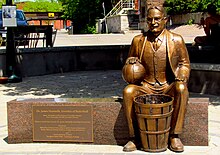James Naismith
From Wikipedia, the free encyclopedia
For the Chemical Biologist, see Jim Naismith.
| Dr. James Naismith | |
|---|---|
 | |
| Sport(s) | College Basketball |
| Biographical details | |
| Born | November 6, 1861 Almonte, Province of Canada,British Empire |
| Died | November 28, 1939 (aged 78) Lawrence, Kansas, United States |
| Coaching career (HC unless noted) | |
| 1898–1907 | University of Kansas |
| Head coaching record | |
| Overall | 55–60 |
| Accomplishments and honors | |
| Awards Naismith Memorial Basketball Hall of Fame FIBA Hall of Fame Canadian Basketball Hall of Fame Canadian Olympic Hall of Fame Canadian Sports Hall of Fame Ontario Sports Legends Hall of Fame Ottawa Sports Hall of Fame McGill University Sports Hall of Fame Kansas State Sports Hall of Fame Inventor of basketball | |
James Naismith (November 6, 1861 – November 28, 1939) was a Canadian American sports coach and innovator. He invented the sport of basketball in 1891. He wrote the original basketball rulebook, founded theUniversity of Kansas basketball program, and lived to see basketball adopted as an Olympic demonstration sport in 1904 and as an official event at the 1936 Summer Olympics in Berlin, as well as the birth of both theNational Invitation Tournament (1938) and the NCAA Men's Division I Basketball Championship (1939).
Born in Canada, Naismith studied physical education in Montreal before moving to the United States, where he developed basketball in late 1891 while teaching at the International YMCA Training School (now Springfield College) in Springfield, Massachusetts.[1] Naismith also studied medicine in Denver, taking his MD in 1898 before moving to the University of Kansas. After a decade (1898–1907) serving there as a faculty member and part-time basketball coach during the sport's fledgling years, he became the Kansas Jayhawks' athletic director. He became a U.S. citizen in 1925 in Lawrence, Kansas.[2][3]
Naismith's contributions to basketball have earned him several posthumous honors, such as in the Canadian Basketball Hall of Fame, the Canadian Olympic Hall of Fame, the Canadian Sports Hall of Fame, the Ontario Sports Legends Hall of Fame, the Ottawa Sports Hall of Fame, the McGill University Sports Hall of Fame, the Kansas State Sports Hall of Fame, and the FIBA Hall of Fame. The Naismith Memorial Basketball Hall of Famein Springfield, Massachusetts, where he is a member of the original Hall of Fame class, was named in Naismith's honor.
Naismith was also a National Guard chaplain with the First Kansas Infantry Regiment. He taught his soldiers basketball to control their excess energy. His effort helped increase morale and even lowered the rate of disciplinary actions among soldiers.
Contents
[hide]Early years[edit]
Naismith was born in 1861 in Almonte (now part of Mississippi Mills), Ontario, Canada.[4] He never had a middle name and never signed his name with the "A" initial. The "A" was added by someone in the administration at the University of Kansas. In 1982 Dr. Naismith's only surviving child stated that his father never had a middle initial "A". The Basketball Hall of Fame also clarifies this as do other members of his family and personal friends of his. Noted historian Curtis J. Phillips has done extensive research on the subject.
Struggling in school but gifted in farm labor, Naismith spent his days outside playing catch, hide-and-seek, or duck on a rock, a medieval game in which a person guards a largedrake stone from opposing players, who try to knock it down by throwing smaller stones at it. To play duck on a rock most effectively, Naismith soon found that a soft lobbing shot was far more effective than a straight hard throw, a thought which later proved essential for the invention of basketball.[5] Orphaned early in his life, Naismith lived with his aunt and uncle for many years and attended grade school at Bennies Corners near Almonte. Then he enrolled in Almonte High School, in Almonte, Ontario, from which he graduated in 1883.[5]
In the same year, Naismith entered McGill University in Montreal. Although described as a slight figure, standing 5 foot 10 ½ and listed at 168 pounds,[6] he was a talented and versatile athlete, representing McGill in Canadian football, lacrosse, rugby, soccer and gymnastics. He played center on the football team, and made himself some padding to protect his ears. It was for personal use not team use.[7] He won multiple Wicksteed medals for outstanding gymnastics performances.[8]Naismith earned a BA in Physical Education (1888) and a Diploma at the Presbyterian College in Montreal (1890).[5] From 1891 on, Naismith taught physical education and became the first McGill director of athletics, but then left Montreal to become a physical education teacher at the YMCA International Training School in Springfield, Massachusetts.[8][9]

No comments:
Post a Comment